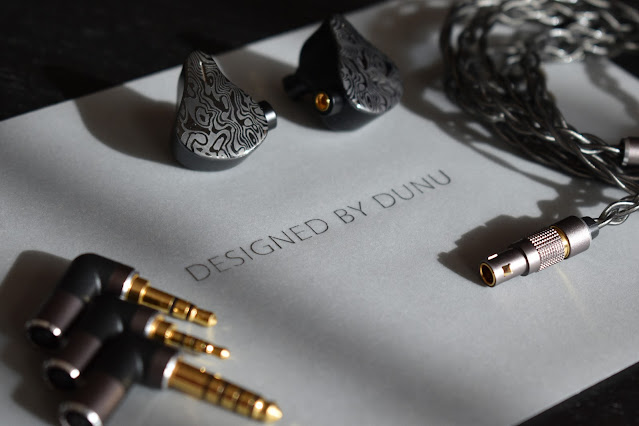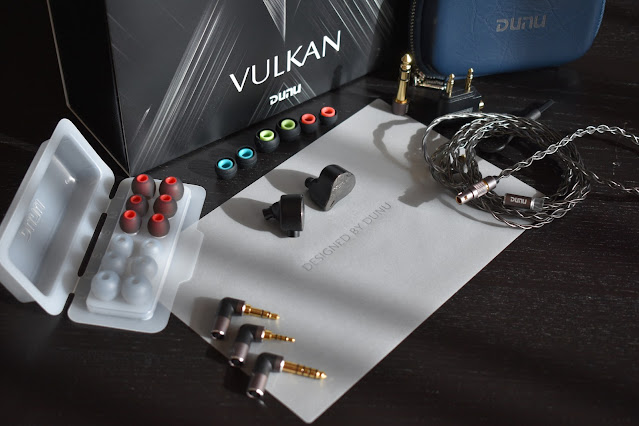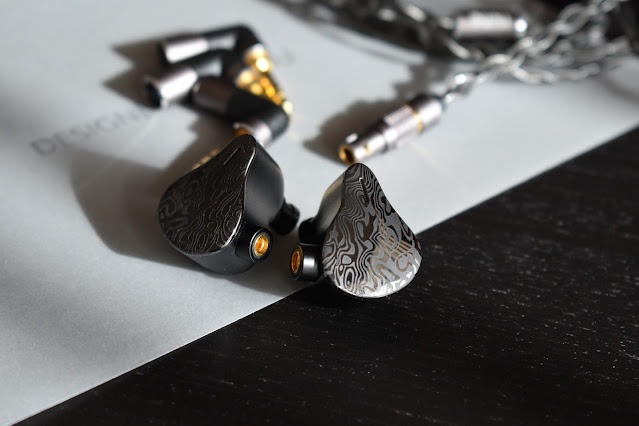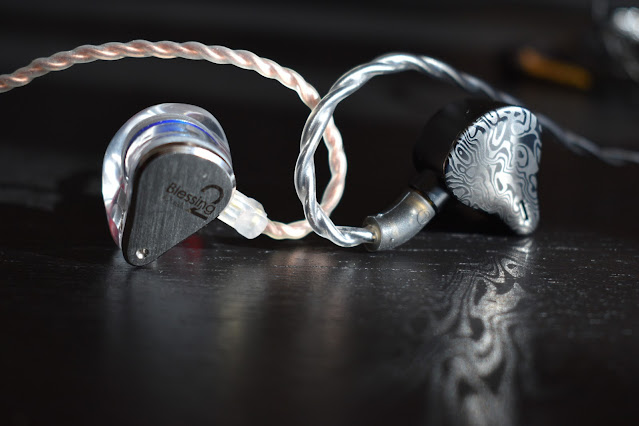- Get link
- X
- Other Apps
English | Español
Also available on YouTube in Spanish: Acho Reviews YouTube
The Dunu Vulkan have been sent to me by Dunu in exchange for the publication of this review. They have not requested anything other than I post my review within 2 weeks of receiving the IEMs, therefore, as always, I will do my best to be as unbiased and honest as possible.
The official Dunu Vulkan page is here: https://www.dunu-topsound.com/vulkan
(non-affiliate link)
Intro…
My experience with Dunu IEMs has been rather small, in fact, until now I have only had the chance to try out the Titan S, a budget set of IEMs that I like quite a bit.
The Vulkan is their latest release which comes in at around 350€, meaning that it is by no means a budget set but is still a long way from the price of many of their upper tier models.
Dunu is no stranger in the IEM world, with many models that have received a lot of praise, along with their cables which, in my opinion, have one of the best modular systems in the game. As I just said, I haven’t tried any of their higher priced IEMs but based on my experience with the Titan S, and all that I have read about other models, I came into this with quite high expectations.
I know there are a couple of reviews out there already of the Vulkan, which I have not read or watched as I knew that I would be receiving a set for review, so I have done my usual process of trying to know as little about these IEMs as possible. I have visited their website, just to get a general overview of what these IEMs contain (and the price), but that is the limit of my knowledge.
The Vulkan are hybrid set of IEMs which feature 2x dynamic drivers, one being an 8mm Cross-Linked Polyethylene Structural Foam Cell Dome with soft surround and the other an 8mm Nanocrystalline Titanium-Coated Diaphragm, along with 4x Knowles balanced armature drivers, two for the Mid-Highs and the other a dual supertweeter.
Now, my knowledge of what all that means with regards to sound and performance is not exactly a lot, so I didn’t know what to expect in terms of sound. What I found, well… I’ll get to that shortly.
Presentation…
The presentation of the Vulkan is nothing short of excellent. Arriving in a box with a flip up lid, inside a cardboard sleeve with brand & model on the front and various specs on the back, the contents are more than one could wish for, even when not talking about a strictly budget set.
Upon opening the box, we find a beautiful set of IEMs with their cable that is just as nice (more on those in build & aesthetics below). Lifting up the top layer we discover the three interchangeable modules for the cable, a plastic tray with 6 sets of tips (two types with an S,M,L of each) and another smaller box containing more accessories.
Inside the accessories box there is a large and good quality carrying/storage case which contains another 3 sets of tips of different sizes, a microfiber cleaning cloth, a small cleaning tool, a 3.5mm to 6.35mm TRS adapter and an airplane adapter.
To be honest, I have no idea why the airplane adapter is included as I am someone who flies quite a lot and it has been decades since I needed one, but it is there in case you do.
The rest of the accessories are of great quality (well, I guess the airplane adapter is also, not that I have any way of testing it) and there is absolutely nothing I can complain about as far as presentation, contents or the quality of what is included.
I don’t appoint scores to things I review (except on Head-Fi where it is obligatory) but if I did, the presentation and contents would get top score from me.
Build & Aesthetics…
No matter where I start here, the answer is going to be the same… excellent.
As I need to start somewhere, let's start with the cable. I already said that Dunu have what I feel is the best IEM modular cable system in the game and the included cable just confirms it. Coming with three interchangeable connectors (plus the 3.5 to 6.35 adapter), 2.5mm + 3.5mm + 4.4mm, you are covered for almost any amp or DAP you would like to use. The connectors are of high quality, as is the connection point.
The cable itself matches my personal preferences well, being lightweight and not too thick, while still refraining from tangling and giving the impression of being very well built. As I have mentioned before, I am not the biggest fan of MMCX connectors but in this case, I will more than forgive them as the connectors are of good quality, they seem like they will last a long time, and to be honest, I really can’t see me wanting to swap the cable for any reason. If I need to change amps, just change the connector at the other end.
As far as the IEMs, they are beautiful. I can say that these are probably the best looking IEMs I have had in my possession. Apart from the build quality, which seems great, the looks are just as good. With a black metal shell sporting a dark metal grey faceplate with a Damascus steel design, they are fancy enough to look special yet discreet enough to not scream “look at me!”.
For comfort, I did find that I struggled to get the left shell to sit comfortably in my ear at first, but after a lot of tip rolling (there are plenty included and I tried a few more that I have on hand), I finally got a very comfortable fit that also seemed to bring out the best in sound from the IEMs.
Again, if I had to score these in this section, they would score just as highly as in the first section.
Sound…
(as always, all tracks mentioned in this review are clickable links that allow you to open the track in the streaming service of your choice).
Before moving on, let me say that I have tried these with multiple sources and I have tip rolled quite a bit. However, in order to stay consistent in my reviews, my sound impressions are based on using them with the iFi Gryphon, no EQ enabled, and the stock red core tips (size M).
As usual, I spent about 4 or 5 days using these almost exclusively before doing any detailed listening or comparisons, and although I did take measurements before getting to my final listening tests, I really didn’t take much notice of the measurements until now.
However, as always, here is a graph of the Dunu Vulkan in comparison to my personal preference target:
(all measurements of the IEMs I review can be found and compared on achoreviews.squig.link)
It is easy to see that the overall frequency response of these IEMs is very close to my preference, a little more elevated in the bass regions that I usually request but the curve is still very similar. As always, preference curves are just an approximation of personal taste, sometimes things that are way off my target are still enjoyable (to me) and sometimes things that are close still don’t seem perfect to me (nothing ever is 😉).
Following my usual review format and starting off with the subbass, there is no roll off to be heard. The extension is good, the presence is good, and I really enjoy this low end. I can’t say that the subbass isn’t great, being very close to my preferences, however, when playing tracks that really make the low end work out, such as the usual “Chameleon”, it does seem that the driver(s) is almost at its limit.
I am not saying that it doesn’t keep, it does a great job of presenting “Chameleon”, which is no easy feat, as it does with other subbass heavy tracks (although not quite to the same level of subbass craziness) like “Bury a Friend” or “Royals”. I didn’t actually come across any well recorded tracks that the Vulkan couldn’t cope with (bad recordings are, well, bad of course).
What I am referring to is that, if you are a certified basshead and need more subbass that the Vulkan offers, I am not sure that adding in more subbass by means of EQ is a good idea. I tried the XBass boost of the Gryphon with the above tracks and, while it was still acceptable, it lost a lot of cleanliness and coherency in the lowest ranges.
Moving into the midbass regions, again we are very close to what I like. In fact, although the actual levels may be slightly above what I would say I like, the curve follows my preferred curve almost exactly, balancing the low end just the way I like it. I much prefer that a set of IEMs increases the presence more as the notes get lower. This just feels much more natural to me, avoiding excessive midbass that can add warmth unnecessarily (even though that warmth does work well with some genres) and instead moving the focus more and more towards the low end as and when it is needed. When a track doesn’t have anything below, let’s say 60Hz, then the additional subbass will not have a negative impact, it will just not play what isn’t there, but when a track with 35Hz presence appears, the IEMs will make it known and not hide it behind a midbass bump.
I find that the Vulkan reproduces bass guitars with authority but without any additional warmth, just the clean tone, as can be heard in the lower notes of the bass guitar in “Elephants On Ice Skates”. Other synthetic bass tracks, such as “Still D.R.E.” or “Get Lucky”, sound just as clean in the midbass section, with good speed and definition, giving a very clean overall presentation in these ranges.
As we move into the mids, the transition is very clean with absolutely no sense of bloat or loss of control in the lower mids. Although I am a fan of the bass frequencies on the Vulkan, I do feel that the mids are the center of attention of this set. Vocals are pushed forwards slightly, although not excessively, just enough to place the light on the vocals a little more.
Some of my most listened acoustic + vocal tracks sound very clean and the voice is certainly the center of attention. As the main peak of the higher mids is at the 3kHz mark (I for one am very happy to not have a peak at 5kHz!), this gives the mids that extra bit of presence but also keeps the harshness in check… mostly.
I say “mostly” because there are many tracks that are recorded with an extra presence in the 3kHz mark already, such as “Crazy”, where this gives Daniela’s voice a little push forwards on most systems, when it coincides with that extra peak of 3kHz on things like the Vulkan, it can come across a little harsh.
When strictly talking male vocals, such as “These Bones”, I find them to be very well balanced and presented, without any unexpected harshness. Adding some female vocals into the acapella mix, such as in the case of “Hallelujah”, I do notice these as a little more “shouty”, with a little more harshness than before..
Moving into the higher ranges, there is a little bit of sibilance happening to those “S” in the “Code Cool” test. They are not the worst, far from it, but they are a little too hot for my taste. These are easily tamed with a very minor EQ tweak (they really aren’t that exaggerated) but, as always, my impressions are based upon not using EQ.
The extension of the upper ranges is not bad and apart from the excessive energy around the 6kHz to 8kHz mark, it is acceptable. I wouldn’t say that the treble is great on the Vulcan, I feel that it could be refined a little more, but it is not terrible and is listenable.
As far as details go, the Vulkan are not a set of IEMs that wow you with tiny details that are found in the background, however, it does do a good job of presenting details in the instruments themselves. As an example, a track that I like to use to evaluate such performance is “All Your Love Turned To Passion”, more specifically the intro of the song. During the intro there is an acoustic guitar that is located in the left channel, with a lot of details happening in the reverb of the room, especially upon striking the body of the guitar. In the case of the Vulkan, then actual playing of the guitar itself is very well presented, with good details in the actual pluck of the strings, however, the reverb and decay in the background is actually quite absent in comparison to other much more detailed sets.
Another thing that I find very impressive on the Vulkan is the sense of openness and space that is created in the sound stage. I am someone who finds 90% of IEMs to be much of a muchness in this regard, with the remaining 10% being divided 80/20 in favour of sets that are pretty bad and very few that are actually good and above average.
The Vulkan is in the group of the very few IEMs that I find above average. There is a nice sense of space, well above average, in which the images are well placed and give me a very enjoyable overall feel. Due to the slight lack in the presence of background details, I can’t say that the imaging has pinpoint precision as there is not enough detail to reach this conclusion, but I must say that the overall imaging is very good.
Binaural recordings, such as “La Luna”, are enjoyable on many sets that are not exactly excellent as far as soundstage and imaging, but with the Vulkan, even recordings that are recorded in a simpler stereo imaging layout are still impressive. “Strange Fruit” has a sense of space between the vocal layers that makes for a very enjoyable experience, as do many other similar songs. Live recordings, such “Hotel California” and many others that I have listened to this week that are not on my usual test list, give a very nice sensation of being spread out, managing to recreate that stage presence that very few IEMs actually do.
Compared to the Letshouer S12…
I don’t usually make many comparisons in my reviews, as I always follow the same review layout, using the same test tracks for detailed listening, which allows comparisons of set just by reading (or watching) my impressions of each set individually.
However, as the Vulkan have come in strong, I feel that I should leave at least some brief impressions against a couple of my preferred sets, the first being the S12, which are a set of IEMs that I grab regularly for “easy listening”.
As far as tuning, the S12 have more warmth in the low end due to having more presence in the midbass range. This lends itself well to easy listening, especially when listening to songs that have a focus on acoustic instruments and other non-bass centric tracks.
I find that the Vulkan sounds more neutral in the lower ranges, without that extra warmth that the S12 provides, however, in the upper ranges I find the S12 to be smoother and more relaxed with a lot of my preferred vocal+acoustic music, a style that I listen to a lot.
As far as details, neither set is spectacular in this regard, both lack a certain amount of the smaller details, focusing on the main presentation rather than what is happening in the background.
I am a big fan of the S12 but I feel that the Vulkan, while being a different presentation, also has a lot going for it in this regard. Depending on music choice I would be drawn to one or the other.
Compared to the Moondrop Blessing 2 Dusk…
The other IEM that I would like to make a brief comparison with is the Dusk. I have had the Dusk for quite some time now and it is still my preferred set when listening to modern pop. By modern pop, I am referring to the usual pop music that has been released in the last 10 years or so, such as “Don’t Start Now” by Dua Lipa or other similarly recorded and mastered tracks.
I feel that the Dusk does very well with this kind of music and I feel that the Vulkan also works well in this regard, until we reach those upper ranges. My main issue with the Dusk is the treble, which is acceptable but not great, something that is also my impression of the Vulkan. The main difference between the two sets is that the Dusk has its upper presence slightly higher than the Vulkan, above the 8kHz mark, and I find that to come across as much smoother in this regard, with less sibilance in the typical “Code Cool” test. It (the Dusk) is still on the “hot” side in this regard but I do find it slightly tamer than the Vulkan.
With regards to detail, I find that the Dusk has the edge here, or at least in the upper ranges. It could be the difference in that upper frequency boost, which gives a false sensation of detail on the Dusk in comparison, but I do feel that I can appreciate details in the background easier on the Dusk than on the Vulkans. However, the details in other ranges, specifically how instruments are played (in the realm of acoustic guitars etc.), the Vulkan possibly edges out the Dusk here, giving a better overall sensation of the instruments.
Where there is no doubt that the Vulkan is superior is in terms of soundstage and imaging. I find there to be much more space and the presentation to be much better in this regard, making a lot of my music far more enjoyable. I would still say the Dusk has the edge for the modern pop side of things but other than that and the 6-8kHz hotness, the Vulkan has so many things going for it that I would rather have it than the Dusk in my collection (having both is even better 😉).
Conclusion…
This has turned into quite a long review but when I feel something is doing something different, it deserves attention, especially if that “difference” is being done well. That is the case with the Vulkan.
There can be absolutely no complaints as far as presentation and included goodies, the build and looks are amazing and the whole package is just, well, great.
In the sound department, it is different enough to stand out from the crowd but at the same time, not so different as to be bizarre and polarizing. As with anything, I am sure there will be people who like the Vulkan and those that don’t, there is no escaping that, but I am firmly in the camp of “likes”.
Yes, there are things that could be improved (in my personal opinion of course), such as a little reduction to that hotness in the treble region and maybe a little more detail, but then maybe we would lose part of what makes the Vulkan different from other IEMs, even in the same Dunu line up.
I am very grateful to Dunu for sending this out as it is always refreshing to spend time with a product that brings something a little different to the table. In the case of the Vulkan, that is something that is deserving of far more praise than complaints.
All FR measurements of IEMs can be viewed and compared on achoreviews.squig.link
All isolation measurements of IEMs can be found on achoreviews.squig.link/isolation
To comment or contact, visit any of the following social media platforms:





%20vulkan.png)



